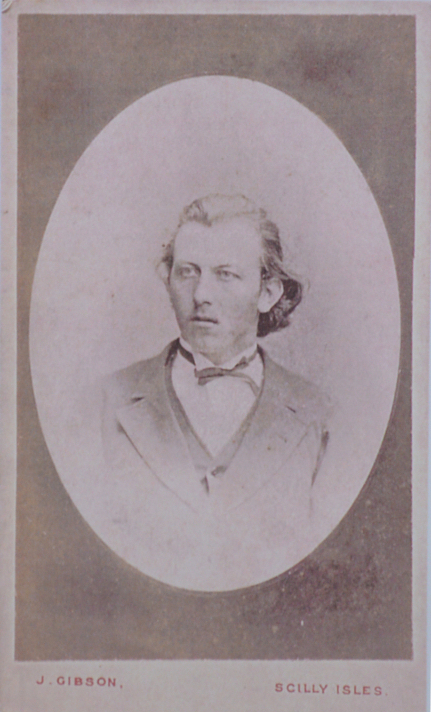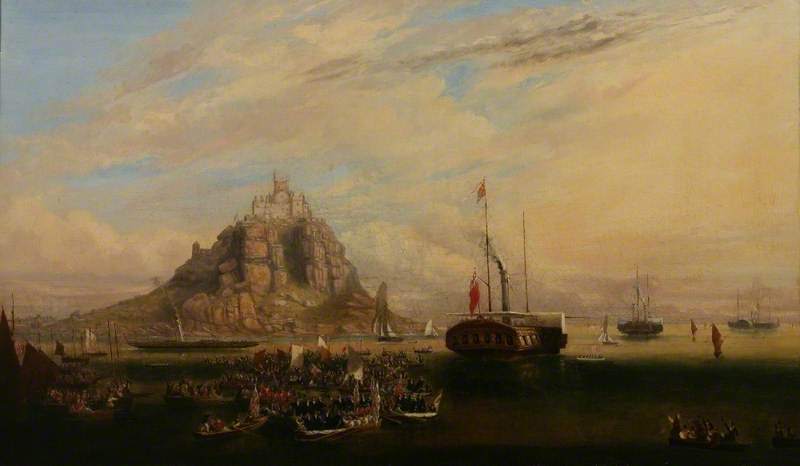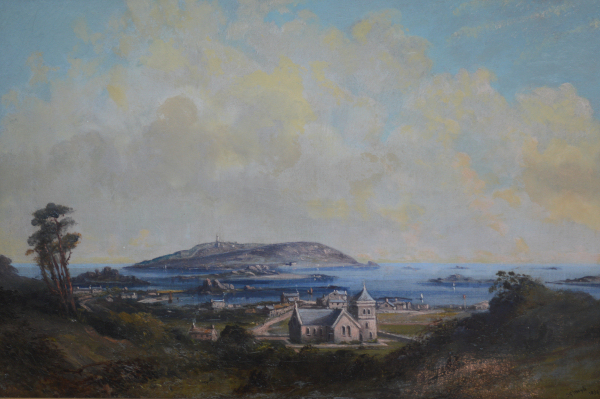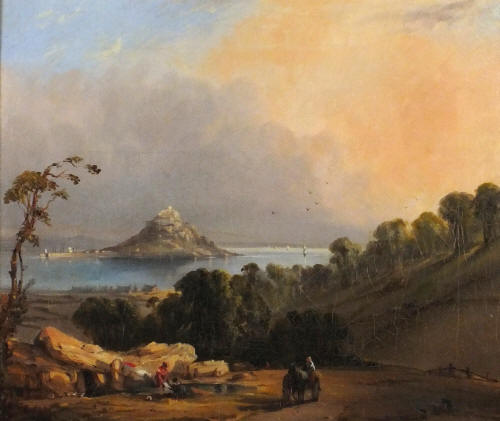|
The
Sailing Surgeon Zelonie Moyle on
19th century painter J.G. Moyle
Dr Richard Moyle was thrown from his
horse-drawn gig in Penzance just after he left his home. He died in 1855,
aged 71 years. His son, Dr John Grenfell Moyle (pictured below), also
relied on a gig to make his house calls, but it was a gig of a different
kind: namely the three-manned boat that ferried him around from island to island
within the Isles of Scilly, some 28 miles from the mainland.
J. G. Moyle was born in Penzance in 1817 and
as a teenager he was commended for a painting he contributed
to the inaugural Falmouth Polytechnic exhibition (1834).
 After his medical training at University College, London,
he made two
voyages to Bombay as surgeon of a ship. Then in 1849 he began his medical
career in the Isles of Scilly, becoming the only doctor for the islands.
He set out from Penzance in the sailing packet 'Lyonesse', leaving there
at 9.00am and arriving at Crow Sound twelve hours later. The same
journey today takes a fraction of the time. After his medical training at University College, London,
he made two
voyages to Bombay as surgeon of a ship. Then in 1849 he began his medical
career in the Isles of Scilly, becoming the only doctor for the islands.
He set out from Penzance in the sailing packet 'Lyonesse', leaving there
at 9.00am and arriving at Crow Sound twelve hours later. The same
journey today takes a fraction of the time.
Scilly was a busy shipping port in those days and the doctor's work
would also take him to the shipping on the Roadstead. The weather would
have been treacherous at times, esp-ecially in winter, but he made a rule
that if the gigs from any of the islands would come, he was always ready
to help.
Moyle married a Scillonian, Eliza James Nance, daughter of Honor and
James Nance of St Martin's, and had a large family of seven daughters
and two sons.
Medical operations at the time would have been starkly different to the
present day. The doctor's own son would later recall the time when he
was needed to help his father while treating a broken leg by sitting on
the patient's chest and arms. Sometimes he would be sent to Mr Dorrien-Smith's
lime pit to get a bucket of 'quenched lime'. The
doctor used the lime for the base of cough and other medicines that he
would have to make for his patients.
Amazingly, he also found time for the creation of many wonderful oil
paintings and drawings. Queen Victoria, Prince Albert and their
courtiers were gloriously depicted in oils, departing from St. Michael's
Mount in 1846 (below). The Royal party were on a Channel cruise and
were anchored in Mount's Bay for two days, aboard the vessels Victoria &
Albert, Fairy, Black Eagle and The Garland. On landing at St Michael's
Mount there was an inspection of the castle. Queen Victoria wore a
muslin dress, a light scarf, a straw bonnet with a vermillion feather
and held in her hand a small but exquisite parasol. The Prince wore a
black dress coat,
 grey pantaloons, a black vest and a light figured
neckerchief. To mark the occasion, the Queen's footprint was pressed in
the form of a brass plaque, engraved with her initials V.R., which can
be seen to this day on the first step. Moyle's depiction of the party
was created for a competition, winning him first prize. Afterwards, he
gave it anonymously to Penzance Council. grey pantaloons, a black vest and a light figured
neckerchief. To mark the occasion, the Queen's footprint was pressed in
the form of a brass plaque, engraved with her initials V.R., which can
be seen to this day on the first step. Moyle's depiction of the party
was created for a competition, winning him first prize. Afterwards, he
gave it anonymously to Penzance Council.
In
another painting Sir
Cloudesley Shovell of the famous shipwreck 'The Association' of 1707
was captured in oils, wading ashore at Porthellick. Indeed it is only by
luck that this painting survived. It was one of the pictures retrieved
by the doctor's own grandson Trevellick, from a house fire at Rocky Hill
much later in 1932. The doctor gave
various lectures at the Scilly Institute. One such lecture was on the
subject of water - its chemistry and wonder. There was a large audience
and more than a hundred people were unable to get tickets, which were
sold on the same day. During the
spring and summer of 1857 Moyle befriended - and became a companion and
travel guide to - Mary Ann Evans and her husband George Lewes who had
several months staying on the islands. Lewes was already an established writer and
philosopher, and in his 'Sea-side Studies' he describes Moyle as 'rubicund'
and 'pleasant'. Within a couple of years Evans became much more widely
renowned as the novelist George Elliot.
 In May 1876 the Cornish Telegraph recorded the
fact that Mr. Moyle, surgeon, St. Mary's, Isles of Scilly, had created a
talented and truthful painting, 'The Burial of the Dead'. The subject of
this piece came from the wreck of the Schiller in 1875, and it was
purchased by Messrs. Hines and Hornsby, fish merchants of Lowestoft. The
painting was to be on view at the auction rooms, Causewayhead. It had
taken twelve months to complete and was for sale tor 200 guineas. In May 1876 the Cornish Telegraph recorded the
fact that Mr. Moyle, surgeon, St. Mary's, Isles of Scilly, had created a
talented and truthful painting, 'The Burial of the Dead'. The subject of
this piece came from the wreck of the Schiller in 1875, and it was
purchased by Messrs. Hines and Hornsby, fish merchants of Lowestoft. The
painting was to be on view at the auction rooms, Causewayhead. It had
taken twelve months to complete and was for sale tor 200 guineas.
Later in life, even when in his seventies. Moyle remained the only
doctor on the islands. He could be seen at the helm of his boat in the
wildest of weather, attired in a pilot's jacket and large boots and
carrying his medical instruments and medicines in his pocket.
There
were a large number of medics in the family. John Grenfell Moyle had an
uncle of the same name, born in 1781, who became the President of the
Medical Board in Bombay. His grandfather was Dr Richard Moyle, born in
1756 — a surgeon at Marazion and Bodmin. Another member of this large
family was Dr Matthew Paul Moyle, a noted photographer, and long after the death of John
Grenfell himself, his great grandson became a doctor, Dr Grenfell
Bailey.
 On retirement in 1890 the doctor was welcomed to a meeting presided over
by his friend, Dorrien-Smith of Tresco Abbey. A presentation was made of an annuity
purchased for the doctor, the amount of £52, plus a purse of gold. It
was given with the greatest of goodwill from his many friends and
patients. On retirement in 1890 the doctor was welcomed to a meeting presided over
by his friend, Dorrien-Smith of Tresco Abbey. A presentation was made of an annuity
purchased for the doctor, the amount of £52, plus a purse of gold. It
was given with the greatest of goodwill from his many friends and
patients. The doctor left the islands
on the November 17, 1890, for the town of Dawlish in Devon. Later, he
moved to Reigate in Surrey where his eldest daughter Emma lived. He
remained there with five of his daughters until his death in 1893, aged
76 years. It was perhaps fortuitous
for him that he decided to retire in 1890, because in January 1892,
influenza swept through the islands. On Tresco some 300 inhabitants
became very ill, there was no one available to run the launch and the
newly installed doctor was too ill to be of any help.
Moyle was buried in Reigate cemetery in plot no. 9184, but the story
doesn't end there. Due to shortage of space in the cemetery, his grave
was later to become the resting place for two other persons. However,
being a man of the people all of his life, I don't think the doctor
would have objected to the company.
Works by Dr John Grenfell Moyle can be seen at the
Penlee House Gallery and Museum in Morrab Road, Penzance, and at the
Isles of Scilly Museum, St Mary’s.
Adapted from an article written for My Cornwall (2010).
Zelonie E Moyle is the great, great granddaughter of John Grenfell
Moyle. |

 After his medical training at University College, London,
he made two
voyages to Bombay as surgeon of a ship. Then in 1849 he began his medical
career in the Isles of Scilly, becoming the only doctor for the islands.
He set out from Penzance in the sailing packet 'Lyonesse', leaving there
at 9.00am and arriving at Crow Sound twelve hours later. The same
journey today takes a fraction of the time.
After his medical training at University College, London,
he made two
voyages to Bombay as surgeon of a ship. Then in 1849 he began his medical
career in the Isles of Scilly, becoming the only doctor for the islands.
He set out from Penzance in the sailing packet 'Lyonesse', leaving there
at 9.00am and arriving at Crow Sound twelve hours later. The same
journey today takes a fraction of the time. grey pantaloons, a black vest and a light figured
neckerchief. To mark the occasion, the Queen's footprint was pressed in
the form of a brass plaque, engraved with her initials V.R., which can
be seen to this day on the first step. Moyle's depiction of the party
was created for a competition, winning him first prize. Afterwards, he
gave it anonymously to Penzance Council.
grey pantaloons, a black vest and a light figured
neckerchief. To mark the occasion, the Queen's footprint was pressed in
the form of a brass plaque, engraved with her initials V.R., which can
be seen to this day on the first step. Moyle's depiction of the party
was created for a competition, winning him first prize. Afterwards, he
gave it anonymously to Penzance Council. In May 1876 the Cornish Telegraph recorded the
fact that Mr. Moyle, surgeon, St. Mary's, Isles of Scilly, had created a
talented and truthful painting, 'The Burial of the Dead'. The subject of
this piece came from the wreck of the Schiller in 1875, and it was
purchased by Messrs. Hines and Hornsby, fish merchants of Lowestoft. The
painting was to be on view at the auction rooms, Causewayhead. It had
taken twelve months to complete and was for sale tor 200 guineas.
In May 1876 the Cornish Telegraph recorded the
fact that Mr. Moyle, surgeon, St. Mary's, Isles of Scilly, had created a
talented and truthful painting, 'The Burial of the Dead'. The subject of
this piece came from the wreck of the Schiller in 1875, and it was
purchased by Messrs. Hines and Hornsby, fish merchants of Lowestoft. The
painting was to be on view at the auction rooms, Causewayhead. It had
taken twelve months to complete and was for sale tor 200 guineas.